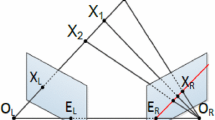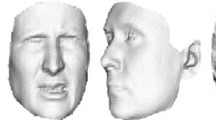Abstract
The overall performances of object recognition techniques under different condition (e.g., occlusion, viewpoint, and illumination) have been improved significantly in recent years. New applications and hardware are shifted towards digital photography, and digital media. This faces an increase in Internet usage requiring object recognition for certain applications; particularly occulded objects. However occlusion is still an issue unhandled, interlacing the relations between extracted feature points through image, research is going on to develop efficient techniques and easy to use algorithms that would help users to source images; this need to overcome problems and issues regarding occlusion. The aim of this research is to review recognition occluded objects algorithms and figure out their pros and cons to solve the occlusion problem features, which are extracted from occluded object to distinguish objects from other co-existing objects by determining the new techniques, which could differentiate the occluded fragment and sections inside an image.











Similar content being viewed by others
References
Abdel-Hakim, A. E., Farag, A. A. (2006). CSIFT: A SIFT descriptor with color invariant characteristics. In computer vision and pattern recognition, 2006 IEEE Computer Society Conference on (Vol. 2, pp. 1978–1983). IEEE.
Agarwal, S., Roth, D. (2002). Learning a sparse representation for object detection. In Computer Vision—ECCV 2002 (pp. 113-127). Springer Berlin Heidelberg.
Akgül, C. B., Rubin, D. L., Napel, S., Beaulieu, C. F., Greenspan, H., & Acar, B. (2011). Content-based image retrieval in radiology: current status and future directions. Journal of Digital Imaging, 24(2), 208–222.
Ansari, N., & Delp, E. J. (1990). Partial shape recognition: A landmark-based approach. Pattern Analysis and Machine Intelligence, IEEE Transactions on, 12(5), 470–483.
Bhanu, B., & Ming, J. C. (1987). Recognition of occluded objects: A cluster-structure algorithm. Pattern Recognition, 20(2), 199–211.
Burghouts, G. J., & Geusebroek, J. M. (2009). Performance evaluation of local colour invariants. Computer Vision and Image Understanding, 113(1), 48–62.
Candes, E. J., Donoho, D. L. (2000). Curvelets: A surprisingly effective nonadaptive representation for objects with edges. Stanford Univ Ca Dept of Statistics.
Candes, E., Demanet, L., Donoho, D., & Ying, L. (2006). Fast discrete curvelet transforms. Multiscale Modeling and Simulation, 5(3), 861–899.
Chang, S. H., Cheng, F. H., Hsu, W. H., & Wu, G. Z. (1997). Fast algorithm for point pattern matching: invariant to translations, rotations and scale changes. Pattern Recognition, 30(2), 311–320.
Chen, C. C., Tsai, T. I. (1993, January). Improved moment invariants for shape discrimination. In San Diego’92 (pp. 270–280). International Society for Optics and Photonics.
Deselaers, T. (2003). Features for image retrieval. Technical Report, Aachen: Rheinisch-Westfalische Technische Hochschule.
Do, M. N., & Vetterli, M. (2005). The contourlet transform: An efficient directional multiresolution image representation. Image Processing, IEEE Transactions on, 14(12), 2091–2106.
Du, T., Lim, K. B., Hong, G. S., Yu, W. M. Zheng, H. (2004). 2-D occluded object recognition using wavelets. Proceedings of the 2004 Computer and Information Technology, 2004. CIT’04. The Fourth International Conference on, 227–232.
Elarbi-Boudihir, M., Rehman, A., & Saba, T. (2011). Video motion perception using operation gabor filter. International Journal of Physical Sciences, 6(12), 2799–2806.
El-Sonbaty, Y., Ismail, M. A. (2003). Matching occluded objects invariant to rotations, translations, reflections, and scale changes. In Image Analysis (pp. 836–843). Springer Berlin Heidelberg.
Fadili, J., & Starck, J. L. (2009). Curvelets and ridgelets. Encyclopedia of Complexity and Systems Science, 3, 1718–1738.
Finlayson, G. D., Chatterjee, S. S., Funt, B. V. (1996). Color angular indexing. In Computer Vision—ECCV’96 (pp. 16–27). Springer Berlin Heidelberg.
Funt, B. V., & Finlayson, G. D. (1995). Color constant color indexing. Pattern Analysis and Machine Intelligence, IEEE Transactions on, 17(5), 522–529.
Gevers, T., & Smeulders, A. W. (2000). Pictoseek: Combining color and shape invariant features for image retrieval. Image Processing, IEEE Transactions on, 9(1), 102–119.
González-Linares, J. M., Guil, N., & Zapata, E. L. (2003). An efficient 2D deformable objects detection and location algorithm. Pattern Recognition, 36(11), 2543–2556.
Gonzalez, R. C., Woods, R. E., & Eddins, S. L. (2004). Digital image processing using MATLAB. Upper Saddle River: Pearson Prentice Hall.
Gruen, A., & Akca, D. (2005). Least squares 3D surface and curve matching. X curvelet Journal of Photogrammetry and Remote Sensing, 59(3), 151–174.
Greenspan, M. A. (2002). Geometric probing of dense range data. Pattern Analysis and Machine Intelligence, IEEE Transactions on, 24(4), 495–508.
Han, M. H., & Jang, D. (1990). The use of maximum curvature points for the recognition of partially occluded objects. Pattern Recognition, 23(1), 21–33.
Hampapur, A., Jain, R., & Weymouth, T. E. (1995). Production model based digital video segmentation. Multimedia Tools and Applications, 1(1), 9–46.
Healey, G., & Slater, D. (1994). Global color constancy: Recognition of objects by use of illumination-invariant properties of color distributions. JOSA A, 11(11), 3003–3010.
Herrmann, F. J., Wang, D., Hennenfent, G., & Moghaddam, P. P. (2007). Curvelet-based seismic data processing: A multiscale and nonlinear approach. Geophysics, 73(1), A1–A5.
Hu, M. K. (1962). Visual pattern recognition by moment invariants. Information Theory, IRE Transactions on, 8(2), 179–187.
Jiayun, W., Bin, L. K., Xiao, C. (2010). Recognition of occluded objects by feature interactions. Proceedings of the 2010 Robotics Automation and Mechatronics (RAM), 2010 IEEE Conference on, 374–379.
Khotanzad, A., & Hong, Y. H. (1990). Invariant image recognition by Zernike moments. Pattern Analysis and Machine Intelligence, IEEE Transactions on, 12(5), 489–497.
Kumar, V. V., Rajput, U. S. N., Sekaran, K. C., Krishna, V. V. (2008). A new method of texture classification using various wavelet transforms based on primitive patterns. ICGST International Journal on Graphics, Vision and Image Processing, GVIP, 8(2), 21–27. Recognition, 2006. ICPR 2006. 18th International Conference on (Vol. 2, pp. 938–941). IEEE.
Lambert, P., Pires, S., Ballot, J., García, R. A., Starck, J. L., Turck-Chièze, S. (2006). Curvelet analysis of asteroseismic data I: Method description and application to simulated sun-like stars. arXIV preprint astro-ph/0604092.
Lamdan, Y., Schwartz, J. T., & Wolfson, H. J. (1990). Affine invariant model-based object recognition. Robotics and Automation, IEEE Transactions on, 6(5), 578–589.
Land, E. H., & McCann, J. (1971). Lightness and retinex theory. JOSA, 61(1), 1–11.
Lim, K. B., Du, T. H., & Wang, Q. (2011). Partially occluded object recognition. International Journal of Computer Applications in Technology, 40(1), 122–131.
Liu, H. C., & Srinath, M. D. (1990). Partial shape classification using contour matching in distance transformation. IEEE Transactions on Pattern Analysis and Machine Intelligence, 12(11), 1072–1079.
Lisin, D. A., Mattar, M. A., Blaschko, M. B., Learned-Miller, E. G. and Benfield, M. C. (2005). Combining local and global image features for object class recognition. Proceedings of the 2005 Computer Vision and Pattern Recognition-Workshops, 2005. CVPR Workshops. IEEE Computer Society Conference on, 47–47.
Lowe, D. G. (2004). Distinctive image features from scale-invariant keypoints. International Journal of Computer Vision, 60(2), 91–110.
Loncaric, S. (1998). A survey of shape analysis techniques. Pattern Recognition, 31(8), 983–1001.
McIntosh, J. H., & Mutch, K. M. (1988). Matching straight lines. Computer Vision, Graphics, and Image Processing, 43(3), 386–408.
Mikolajczyk, K., & Schmid, C. (2005). A performance evaluation of local descriptors. Pattern Analysis and Machine Intelligence, IEEE Transactions on, 27(10), 1615–1630.
Moreels, P., & Perona, P. (2007). Evaluation of features detectors and descriptors based on 3D objects. International Journal of Computer Vision, 73(3), 263–284.
Muhsin, Z. F., Rehman, A., Altameem, A., Saba, T., & Uddin, M. (2014). Improved quadtree image segmentation approach to region information. The Imaging Science Journal, 62(1), 56–62.
Murase, H., & Nayar, S. K. (1995). Visual learning and recognition of 3-D objects from appearance. International Journal of Computer Vision, 14(1), 5–24.
Murtagh, F., Starck, J. L. (2006). Astronomical image and data analysis. Springer.
Rehman, A. Saba, T. (2014). Features extraction for soccer video semantic analysis: Current achievements and remaining issues. Artificial Intelligence Review, Vol. 41(3), pp: 451–461. doi: 10.1007/s10462-012-9319-1.
Saba, T. Rehman, A. (2012). Machine Learning and Script Recognition, Lambert Academic publisher, pp:29–34.
Neamah, K. Mohamad, D. Saba, T. Rehman, A. (2014). Discriminative Features Mining for Offline Handwritten Signature Verification, 3D Research vol. 5(3). doi. 10.1007/s13319-013-0002-3
Sayed, U., Mofaddel, M. A., Abd-Elhafiez, W. M., & Abdel-Gawad, M. M. (2013). Image object extraction based on curvelet transform. Applied Mathematics, 7(1), 133–138.
Schmid, C., Mohr, R., & Bauckhage, C. (2000). Evaluation of interest point detectors. International Journal of Computer Vision, 37(2), 151–172.
Slater, D., & Healey, G. (1996). The illumination-invariant recognition of 3D objects using local color invariants. Pattern Analysis and Machine Intelligence, IEEE Transactions on, 18(2), 206–210.
Sumana, I. J. (2008). Image retrieval using discrete curvelet transform (Doctoral dissertation, Monash University, Australia).
Singha, M., & Hemachandran, K. (2011). Performance analysis of color spaces in image retrieval. Assam University Journal of Science and Technology, 7(2), 94–104.
Soleimanizadeh, S., Mohamad, D., Saba, T., & Rehman, A. (2015). Recognition of partially occluded objects based on the three different color spaces (rgb, ycbcr, hsv) 3D research. Springer, 6(3), 1–10.
Starck, J. L., Candès, E. J., & Donoho, D. L. (2003). The curvelet transform for image denoising. Image Processing, IEEE Transactions on, 11(6), 670–684.
Swain, M. J., & Ballard, D. H. (1991). Color indexing. International Journal of Computer Vision, 7(1), 11–32.
Tsang, P. W. M., Yuen, P. C., & Lam, F. K. (1994). Classification of partially occluded objects using 3-point matching and distance transformation. Pattern Recognition, 27(1), 27–40.
Teh, C. H., Chin, R. T. (1988). On image analysis by the methods of moments. Pattern Analysis and Machine Intelligence, IEEE Transactions on, 10(4), 10(4): 496–513, 1988.
Tuytelaars, T. Mikolajczyk, K. (2008). Local invariant feature detectors: a survey. Foundations and trends® in computer graphics and vision, 3(3), 177–280.
Zhang, D., Islam, M. M., Lu, G., & Sumana, I. J. (2012). Rotation invariant curvelet features for region based image retrieval. International Journal of Computer Vision, 98(2), 187–201.
Zhao, D., & Chen, J. (1997). Affine curve moment invariants for shape recognition. Pattern Recognition, 30(6), 895–901.
Zhang, D., & Lu, G. (2004). Review of shape representation and description techniques. Pattern Recognition, 37(1), 1–19.
Author information
Authors and Affiliations
Corresponding author
Rights and permissions
About this article
Cite this article
Soleimanizadeh, S., Mohamad, D., Saba, T. et al. A Taxonomy of 3D Occluded Objects Recognition Techniques. 3D Res 7, 4 (2016). https://doi.org/10.1007/s13319-016-0080-0
Received:
Revised:
Accepted:
Published:
DOI: https://doi.org/10.1007/s13319-016-0080-0




